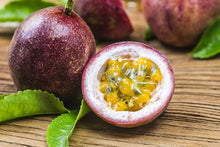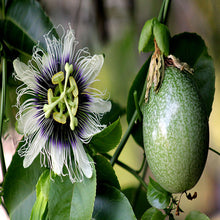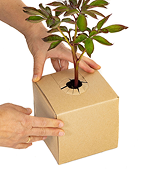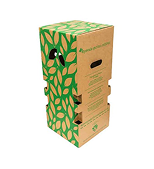- Home
- Flowerings
- Passion Fruit - Fruit...
Passion Fruit - Fruit Plants & Vine Plants





Passion Fruit - Fruit Plants & Vine Plants

 Climate
Climate Time to yield
Time to yield Maximum size
Maximum size


Damaged or lifeless? We’ll replace it for free. Learn more




Double layered custom boxes to protect plants during shipping.

Air vents for proper air-flow

To preserve plant freshness during transit

Details steps of how to grow and maintain your plant
Passion fruit is botanically known as Passiflora edulis, which is a vine species from the Passionflower family. It is cultivated commercially in a tropical and subtropical climate. It is mainly grown for its sweet, seedy fruit. The fruit is a type of berry round to oval, either yellow or dark purple at maturity, with a soft to firm, juicy interior filled with numerous seeds. The fruit is both eaten and juiced, the juice is often added to other fruit juices to enhance the aroma.
It is a perennial vigorous climbing vine, usually, the vine produces a single flower. The fruit produced is entirely fleshy, and is spherical to ovoid. The outside color of the berry ranges from dark purple with fine white specks to light yellow. Within the fruit, there are typically 250 black seeds, each 2.4 mm in length, each seed is surrounded by a membranous sac filled with pulpy juice. The flavor of the juice is slightly acidic and musky. The passion fruit's flavor can be compared to the guava fruit.
MAXIMUM HEIGHT - Its growth is unlimited but normally grows between 8 - 12 meter height.
BLOOMING YEAR - It blooms mainly in May - June, and September - October.
FRUITING YEAR - It starts fruiting after 1.5-2.5 years after planting.
GROWING TIPS -
- It can grow almost in all types of soil, but the soil should be well-drained, fertile, and organic in nature.
- For fast growth, it needs support, the more support it will grow very quickly, as it is a fast-growing plant.
- It can grow either in full sunlight or partial sunlight(3-4hours) is also okay to grow.
- It can be planted in the medium to large size pot, but for more spreading, preferred to plant directly in the soil.
INSIDE THE BOX
-
S.No. PRODUCT NAME DIMENSION 1. Passion Fruit Plant 1 Feet Height 2. Growing Pot (Black color) 6 Inch *above specifications are for indicative purposes only, actual dimensions may slightly vary.
PLANT CARE
LIGHT CONDITION - It requires a minimum of more than 4 hours of Direct Sunlight. It can also grow in semi-shade areas. (minimum 3hours of sunlight)
WATERING SCHEDULE - Water when the topsoil(2-3 inches) feels dry to touch. Always maintain moisture near the root zone.
SOIL TYPE - The soil should be well-drained, fertile & rich in organic content.
FERTILIZER APPLICATION - Apply any organic fertilizer once a month for better health of the plant, apply water immediately after fertilizer application.
PLANT PROTECTION - Do regular pruning of the plant in order to maintain good required shape. Remove dead, infected, or damaged plant parts and discard them away from the plants. Generally, it is not affected by any pest & disease in case of any insect attack or disease, you can use Neem oil, Eucalyptus oil, or Citrus oil spray for primary treatment.
INITIAL CARE FOR 10-15 DAYS JUST AFTER RECEIVING YOUR PLANT
- Remove the Packaging Materials carefully.
- Press the soil in the pot & add additional soil(garden mix) if necessary.
- Maintain moisture in the pot, Do not overwater it may kill your plant, so make sure that the soil should be dry between watering.
- Provide support with stick/moss stick(vine plant) in order to make straight growth, for needed plant only.
- Make sure that plants get enough morning direct bright light for 10-15 days & do not go for immediate transplanting(minimum 1 month)
- Just prune if any branch of the plant is get damaged in transit.
Selected plant of 8-10 inches
Planted into a 5-inch pot
With healthy, moisture-retaining soil
A care instruction sheet for maintenance guide

Get in touch for best pricing on bulk orders and landscaping projects.
 WhatsApp us
WhatsApp us

Call on 9177805454 (Mon-Sat, 9 AM-6 PM) or WhatsApp us – we’re here to help.
About Exotic Flora
At Exotic Flora, we’re passionate about bridging the gap in bringing plants to everyone. With over 500+ varieties across 7 plant categories, from exotic finds to everyday greens, we bring the entire range to you.
Our plants, sourced from all parts of India are nurtured at Kadiyam, in our 25 acres in-house nursery by a team of expert horticulturists. Once they are ready we ship all our plant varieties across India.
Our services go beyond safe delivery of plants. A dedicated support team is there to help you with any maintenance queries you may have.
At Exotic Flora we always believe in going that extra mile, because everyone should have the plants they love.
Every, fruit plants vary in their fruiting time, depends on location, climate & age of the plants. Generally, Grafted fruit plants starts fruiting within 2 years of planting, where as non-grafted plants take more than 2 years. You can check the fruiting time of each plant in the plant description.
No, Majority of fruit plants are not delivered with fruits. But some grafted fruit plants can be delivered with fruits and flowers mostly Citrus, Guava, Star fruit, Fig, Ber etc. But it is recommended to remove the flowers during early days, so that plants can get more branches and physical strength.
Grafting is a technique where two plants part are combined together so that they can grow together. Most commonly seen in Mango. Air Layering is also a vegetative propagation technique where a plant is produced while it is still attached to its parent's plants. Commonly seen in Guava. Stem cutting is a vegetative propagation technique, where soft, semi-hard, or hardwood stem is cut with 2-3 nodes and used for the multiplication of plants. Commonly seen in flowering & ornamental plants.
Yes, the grafted fruit trees produce fruit earlier, than the non-grafted fruit plants.
These are some of the rare and new fruit plants and it's varities, which are not avialable everywhere in our country.
Remove the plant from its pot. Make sure to not disturb the root ball. Place the plant in a prepared pit(1x1ft) or slightly bigger pot than the current pot. Firm the soil around the plant with your hands. Water well till it drains out from the drainage hole.
In order to maintain the good shape of the plants, proper care should be taken from the beginning like the pruning of unwanted and diseased parts of plants, stalking to young plants, regular maintenance of plants.
In General, a grafted/air layered/hybrid fruit takes 2 years for fruiting, whereas seeded grown plants take 4-5 years of time for fruiting. But it may vary depending on the plant types.
In general if your soil weell drained, fertile and organic in nature, it will produce good quality fruit. Sandy-loamy is the most preferable soil used for fruit plants.
Size and taste of each fruit plants varies depending on the varieties. You can find more details about each fruit plants in terms of size and taste in the description of individual plants.
Initial first 2 years are very important to feed the plants with organic manure and fertilizers regularly. It is recommended to add organic manure or compost to each plant in every 3 months of time intervals. Do not go for Chemical fertilizers it will weaken the plants in future.
Plastic pots with drainage holes preferably work best as they are lighter to move around. Any other container which is light in weight with a drainage hole can also work to grow fruit plants.
Packaging was good. Plants came like sticks but with pots. I've kept them in their original pots till now and new leaves have grown since then. So good experience as the plants were alive and now thriving. Thank you. Have ordered for more plants now. My go to place to order for plants as Amazon sends dead plants/seeds.
There is a good selection of plants. Plants were very well packaged and arrived in good condition. The only issue is that delivery takes a long time and responses to queries are incomplete; you are asked not to worry but no further information is provided about when to expect delivery.
Is it suitable for hill station?
We ve lots of passion fruits in our state . How much you get in Kg . Reply back , thanks
